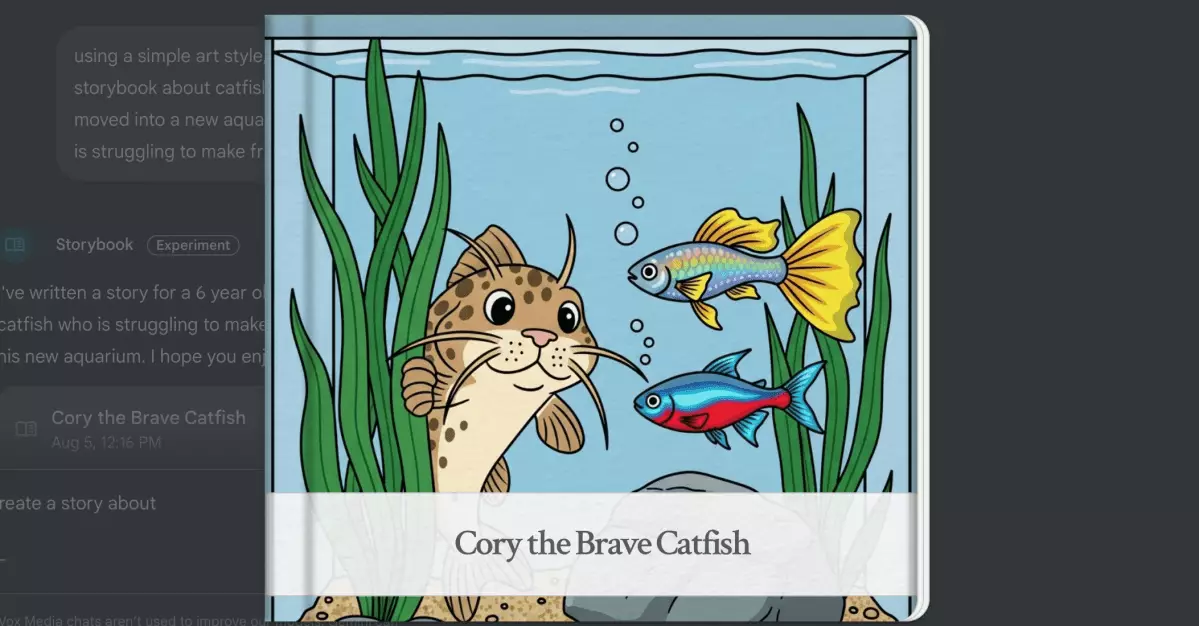In recent years, the integration of artificial intelligence into creative processes has ignited both excitement and skepticism. Google’s latest innovation, the Gemini AI chatbot’s “Storybook” feature, exemplifies this shift by allowing users to craft personalized illustrated stories through simple descriptions. This tool promises a democratization of storytelling, where anyone—from parents to educators—can conjure enchanting narratives tailored by their imagination. The concept of generating a story with accompanying art styles like anime, claymation, or comic aesthetics offers a tantalizing glimpse into the future of interactive storytelling, blurring the lines between human creativity and machine assistance.
This technological leap is fundamentally empowering, opening avenues for unique artistic expression that did not previously exist at such accessibility levels. Users can custom-design tales by describing characters, scenarios, or visual styles, and even reference their own images, transforming the AI into a collaborative partner. With the ability to generate 10-page stories accompanied by speech synthesis, the tool positions itself as an all-in-one storytelling companion that fosters engagement, educational entertainment, and artistic experimentation.
However, beneath the surface of this innovation lie notable imperfections. The enthusiasm around AI-driven creativity often glosses over the inconsistencies and quirks that still plague this nascent technology. Despite the allure of effortless storytelling, AI-generated illustrations and narratives sometimes falter, revealing the limitations of current algorithms and datasets.
The Challenges of Artistic Precision and Narrative Coherence
One of the most critical issues with AI art and storytelling emerges from the unpredictable nature of machine-generated content. As observed by early users, the Gemini Storybook occasionally produces illustrations riddled with bizarre anomalies—such as characters with misplaced limbs, inconsistent design elements, or uncanny visual distortions. For instance, a seemingly straightforward request for a story about a fish seeking friendship resulted in images with inexplicable human arms attached to aquatic creatures or scenes that resembled a chaotic crime scene rather than a whimsical children’s tale.
These peculiarities do more than just amuse; they highlight the ongoing struggle AI faces in achieving artistic fidelity and narrative cohesion. When an AI misplaces a character’s anatomy or creates a scene that contradicts the intended story, it undermines the immersive experience. Such inconsistencies may disrupt young audiences’ engagement or diminish the perceived professionalism of the content—factors crucial in children’s media or educational settings.
Furthermore, the AI’s struggle to maintain visual and thematic consistency across the entire story reveals a deeper flaw: a lack of genuine understanding. AI models generate images based on statistical patterns rather than conceptual comprehension, resulting in visual “glitches” that reflect their data-driven, but sometimes superficial, grasp of art styles and storytelling nuances.
The Limitations of AI’s Artistic Interpretation and User Expectations
Another layer of the challenge revolves around the AI’s interpretation of artistic styles and user input. When asked to craft drawings inspired by specific art genres, the results are often hit-or-miss. For example, attempting to force a claymation aesthetic may result in images that resemble poorly assembled models, while anime-inspired scenes might lack the fluidity and emotional expressiveness expected.
This discrepancy raises questions about user expectations versus AI capabilities. Many users might assume that AI can mimic complex artistic techniques with high fidelity, but the reality is that current models are still in their infancy, producing compromises that are sometimes jarring or humorous rather than polished. Even for the technologically savvy, this mismatch can lead to frustration, especially when images seem inconsistent with the descriptive prompts provided.
Additionally, the experience of uploading personal images, such as child’s drawings, reveals another limitation. Despite offering this feature as a means to personalize stories, the AI often struggles to integrate such images seamlessly into the narrative, sometimes creating scenes that appear disconnected or inconsistent with the source material. This reflects an area where AI’s interpretative skills need significant refinement before it can truly serve as a creative partner.
Looking Forward: The Promise and the Path for AI in Creative Arts
While the current state of AI storytelling tools reveals a mix of remarkable potential and technical flaws, dismissing their value would be shortsighted. The ongoing evolution of artificial intelligence in arts and storytelling suggests that these hiccups are temporary hurdles on the journey toward more refined and reliable creative aids.
The key to unlocking AI’s full potential lies in ongoing improvements in training datasets, algorithmic sophistication, and aesthetic understanding. As models become more advanced, they are likely to produce visuals that better align with human artistic visions, minimizing bizarre anomalies and enhancing narrative coherence. Furthermore, increased user feedback and iterative development can help bridge the gap between AI’s current creative limitations and society’s demand for high-quality, customized content.
While AI-driven storytelling tools like Google’s Gemini Storybook open exciting doors for personal and educational creativity, they should be approached with a mix of enthusiasm and skepticism. Embracing these tools as collaborative experiments rather than perfect solutions will allow creators to harness their innovative potential fully—without overlooking the imperfections that still demand attention. With continued refinement, AI might one day become not just a tool but an inspiring partner in the endless human pursuit of storytelling.

